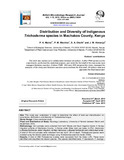Distribution and diversity of indigenous Trichoderma species in Machakos County, Kenya.

View/
Date
2015Author
Maina, P K
Wachira, PM
Okoth, SA
Kimenju, JW
Language
enMetadata
Show full item recordAbstract
Aim: This study was undertaken in order to determine the effect of land-use intensification on occurrence, distribution, and diversity of Trichoderma fungus. Study Design: Cross-sectional study. Place and Distribution of Study: Mycology Laboratory, University of Nairobi between March and September, 2014. Methodology: Soil samples were collected from both Mwala and Kauti irrigation blocks in Kabaa irrigation scheme of Machakos County, in Kenya under three land use types (LUTs): intensively cultivated farmlands under irrigation, rainfed intensively cultivated farmlands and undisturbed lands. A total of 100 soil samples were obtained from the top 0-20 cm depth. Trichoderma species were isolated using the dilution plate technique using Trichoderma-selective media (TSM). Results: A total of 369 Trichoderma isolates were recovered from the three LUTs. These were identified and classified into eleven species. The species identified were: T. harzianum, T. koningii, T. viride, T. asperellum, T. atroviride, T. spirale, T. virens, T. tomentosum, T. brevicompactum, T. crassum and T. hamatum. The most abundant Trichoderma species was T. harzianum with a frequency of isolation of 38.87%, followed by T. koningii and T. viride at 18.03 and 15.49%, respectively. Trichoderma hamatum had the least isolation frequency at 0.41%. T. harzianum also had the widest distribution. The difference in abundance of Trichoderma in the three LUTs was significant (P=0.05). The undisturbed lands had a higher abundance of Trichoderma compared to the disturbed areas. Mwala irrigation block A had the least abundance while block D which is more recent in cultivation had highest mean abundance of Trichoderma. Difference in Trichoderma species mean richness between LUTs was not significant (P=0.203). Undisturbed lands had the highest richness. Undisturbed lands also had the highest diversity while irrigated lands were the least diverse Conclusion: Enhanced land-use intensification lowers the abundance and diversity of Trichoderma in the soil.
URI
http://www.cabdirect.org/abstracts/20153265025.html?resultNumber=0&q=au%3A%22Maina%2C+P.+K.%22http://hdl.handle.net/11295/89680
Citation
British Microbiology Research Journal 2015 Vol. 9 No. 4 pp. BMRJ.18034Publisher
University of Nairobi
